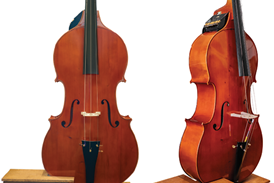- News
- For Subscribers
- Student Hub
- Playing Hub
- Directory
- Lutherie
- Magazine
- Magazine archive
- Whether you're a player, maker, teacher or enthusiast, you'll find ideas and inspiration from leading artists, teachers and luthiers in our archive which features every issue published since January 2010 - available exclusively to subscribers. View the archive.
- Jobs
- Shop
- Podcast
- Contact us
- Subscribe
- School Subscription
- Competitions
- Reviews
- Debate
- Artists
- Accessories
Trade Secrets: Repairing damaged blocks

A conscientious method that preserves as much information as possible for future restorers
At the start of a repair, a luthier will normally look inside an instrument for clues as to its maker. The label might be one example but there may also be signatures or stamps in the interior, and possibly information from the construction of the blocks and linings. It is surprising how much can be gleaned from these – they can, for instance, tell us whether an internal or external mould was used, and if it was an internal mould, we can even work out what it might have looked like. For this reason, it is often dismaying to note how quick restorers have been to replace blocks and linings. However, if the blocks have suffered significant cracks or woodworm damage, such that they can no longer withstand the forces exerted by the button or joints, how can we avoid replacing them?
Recently I decided to tackle this problem with my students, and we came up with a solution that satisfies these twin requirements:
• to safeguard the information contained in the block (i.e. where and when it was made; how; with what; and by whom)
• to be practical (i.e. we want the method to catch on, and to be used by as many repairers as possible)
Our solution involves removing the inner part of each block and replacing it with new wood, while retaining the outer parts of the original block. The repair process is surprisingly quick, and requires a lathe, a bandsaw and an oscillating spindle sander (all commonly found in workshops). We performed the operation on the top- and bottom-block of a violin.
Already subscribed? Please sign in
Subscribe to continue reading…
We’re delighted that you are enjoying our website. For a limited period, you can try an online subscription to The Strad completely free of charge.
* Issues and supplements are available as both print and digital editions. Online subscribers will only receive access to the digital versions.


























